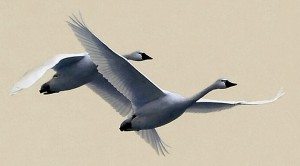Photo and story by Casey Lessard
A sight to see, thousands of tundra swans are now back at the Thedford Bog behind the Lambton Heritage Museum. The bog is a natural staging area for the swans, who are on their way from Chesapeake Bay, Maryland, to cooler climates in Canada’s North for the summer. The trip is 6,500 km, so it’s understandable they’d want to stop for a rest and some food. Here, that includes the grains left in the fields from the fall harvest.
 To celebrate the annual migration, the Lambton Heritage Museum (on Highway 21 south of Greenway Road) hosts the Return of the Swans festival. With displays, videos, and other resources, the museum is a good home base to learn more about North America’s smallest and most abundant swan.
To celebrate the annual migration, the Lambton Heritage Museum (on Highway 21 south of Greenway Road) hosts the Return of the Swans festival. With displays, videos, and other resources, the museum is a good home base to learn more about North America’s smallest and most abundant swan.
For the month of March, the Lambton Heritage Museum is open daily from 10 a.m. to 5 p.m.. Admission is $5 for adults, $4 for seniors/students, $3 for children, and $15 for the family.
The best source of updates for people interested in watching the birds is the museum’s website, http://www.returnoftheswans.com, which has a migration report that is updated daily with locations where the birds are gathered. If you don’t have internet access, you can also call 1-800-265-0316.
If you go
Dress warmly and bring binoculars. If you plan to take photographs, here are some tips from the publisher:
– Assume you will need a long telephoto lens (at least 300mm). The birds are pretty far away, but there are locations where they fly over a road to move from field to field, and here you need only about 100mm. This is where I stand because you can capture them coming at you, and then over you. Just watch out for small falling objects.
– Remember to look behind you. If they fly toward you and over, they will come back later.
– Use a fast shutter speed (1/1000 or faster). These birds flap their wings quickly, so if you want sharp images, you need to freeze that motion. I try to get to about 1/4000 if I can. Can’t get that high? You might need to raise your ISO (but if it’s daylight, try to avoid higher than ISO 800)
– Use a slow shutter speed with a tripod. Breaking the rules can get some interesting motion photos. This works best in lower light.
– Use your burst mode or continuous shooting mode. You’ll want to take a rapid series of shots to get one you like. There are times when you wait five minutes for 20 seconds of action.
– If you use continuous shooting, make sure your focus is set to Servo AF, which means the camera continues to focus as long as you hold the shutter button down. Remember that the birds are constantly changing your focal point.
– Shoot at your highest resolution. You will have to crop most of these photos later.
– Bring lots of memory cards or film. You will shoot a lot, and you might get a couple of good shots from the whole day. It’s worth it, though.
– Try to arrive early. The light will give you good texture and colour, and you might be the only one there.

